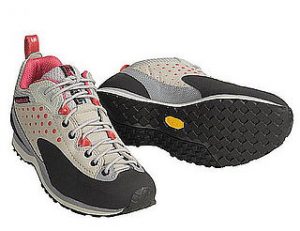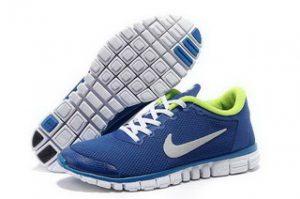Footwear and Clothing
Proper footwear and clothing are fundamental to having an enjoyable outdoor experience, and nothing can turn an otherwise fun activity miserable or even dangerous than wearing inappropriate shoes (or flip flops) or the wrong clothes for the conditions.
Footwear
Southern Utah is a proving ground for footwear. High temperatures in the lower desert areas combined with sharp rock, sand, spiky vegetation, and even wet muddy conditions in canyon bottoms are brutal on shoes. Higher elevations may combine wet conditions with unexpected snow during any month of the year, and going from hot glue melting temps to alpine snow is often a matter of a couple thousand feet of elevation. Good footwear for all these conditions will inevitably involve come compromises, but some choices are far better than others. A good shoe for outdoor activities in this part of the world would have the following qualities:
Footbed support:
A midsole of similar footbed provides a stable platform of protection and support between the ground and the foot. Feeling every pebble underfoot is an excellent method of making even the shortest hike a march of misery. Light weight foam bottomed running shoes are a great example of too little footbed support, the desert terrain also tears these shoes up quickly. Conversely walking around feeling that there is a two by four strapped to the bottom of your foot is also less than optimal…, (think steel shanked backpacking boots) Finding a middle ground between these extremes is often a process of trying on and using multiple brands in a wide range of conditions, and also understanding how the shoe may soften after some period of use.
Sole:
Old school vibram lug soles and great for high altitude backpacking trips through wet, muddy conditions, and the multi day rainstorms encountered during a hike of the Appalachian trail, but conditions in this part of the country require a different type of sole. Generally we are moving across sedimentary stone of one sort of another and a sole that is designed with this movement in mind will be far superior to one that is designed around mud. The advent of sticky climbing shoe rubber compounds applied to hiking shoes makes for a very good type of sole material due to its ability to provide great traction on angled stone, and even provide good grip on the wet conditions found in the bottom of slot canyons.
Uppers:
The warm to hot temperatures here during much of the year put a premium on breath-ability, after all no one wants to walk around with their feet encased in miniature sauna’s all day long. Yet with good breathe ability comes many openings wide enough for all sorts of detritus to enter the sanctum of the sock, and before long the sand in the wash is hitching a ride in your shoes. So finding a good balance between a shoe that breathes and one that keeps the sediment out is the holy grail of desert footwear. Go down a canyon and another issue becomes how well do the shoes drain the water that occupies the lowest and nastiest potholes and trenches in the magnificent slot canyons we have around here. Walking for miles in a non draining shoe will turn even the gnarliest hobbit feet into soft prunes making them prone to blisters. The waterproof breathable’s, while seemingly the perfect solution of sand barrier and air flow, do not provide the kind of ventilation that walking around on 120 degree ground mandates. These temperatures are common through out the summer season and most of our staff find these shoes to be foot furnaces, as well as too costly when we consider the abuse that we put them through. Many of our guests ask about high top vs. low top shoes and hiking boots. Our advise is always based on the type of activity that we are going to be taking them on, as well as whether they have any ankle issues that may be aggravated with a shoe that does not provide side to side support. Most of our staff exclusively wear low top hiking and approach shoes for the combination of their lower weight, good ventilation / breathe ability, and the flexibility they offer to position our feet when scrambling or climbing.
Appropriate Footwear Inappropriate Footwear


Clothing
Desert areas are places of extremes, and while it may sometimes be extremely hot, even the days that end up at 115 will often begin in the 70’s. Winter temperatures are even more extreme, with 30 degree differences in temperature existing only a few feet apart whether in the sun or shade. Finding a clothing system able to deal with these kind of wide ranging conditions is often challenging, and requires a good amount of forethought.
Generally speaking a good layering system of synthetic garnets is the best solution to having the flexibility to deal with the changeable conditions that define desert regions. Cotton is to be avoided during most of the year, as it does not provide any insulation when it gets wet from either precipitation or perspiration, and also takes a long time to dry out. Standing in a breezy, shady, canyon clad only in a cotton t-shirt is either a great way to dissipate heat, or court hypothermia depending on the conditions, and a synthetic will dissipate heat nearly as well, just not for as long, as they tend to dry out quickly.
Sun:
Sun protection is accomplished with light colored loose clothing that has a high enough density to provide a significant SPF (sun protection factor) Special attention should be given to hats that cover both the top of the head as well as the tops of the ears and cast a bit of shade over the neck. Ventilation below the crown of the hat will allow the airflow to keep the head cooler, potentially preventing heat related conditions like heat exhaustion or heat stroke. The head and neck are the most efficient parts of the body from which to loose heat, along with armpits and crotch areas. Keeping these areas covered and insulated during cold weather (wool hat, and scarf) and ventilated during the hot months, allows either heat retention or heat loss through evaporation respectively.
Wind:
Desert regions are typically subject to high winds during frontal passages, and this area is no exception. Spring is often an especially windy time of year, with afternoon gusts frequently topping 40mph. Windproof layers are generally very compressible and will easily stuff into the bottom of a day pack, and also can be as inexpensive as coated nylon windbreakers to add a significant amount of comfort. Waterproof breathable layers are extremely windproof and will also offer added protection in an unexpected downpour